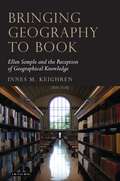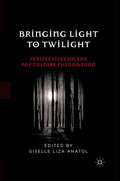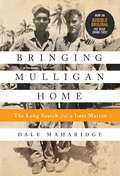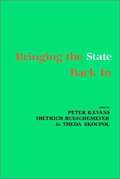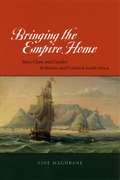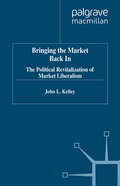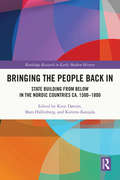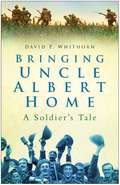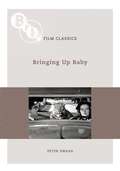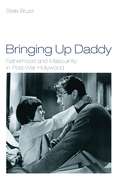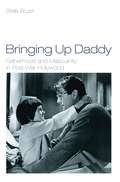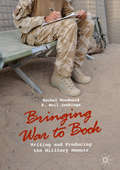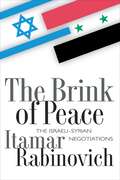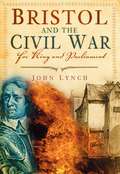- Table View
- List View
Bringing Down the Duke: swoony, feminist and romantic, perfect for fans of Bridgerton (A League of Extraordinary Women #1)
by Evie Dunmore'I have read the future of historical romance, and it's Evie Dunmore' EVA LEIGH, author of Dare to Love a Duke _________________Oxford, 1879. A beautiful bluestocking is about to teach a duke a lesson . . .Brilliant but destitute Annabelle Archer is one of the first female students at Oxford University. In return for her scholarship, she must recruit influential men to champion the rising women's suffrage movement. Her first target is Sebastian Devereux: cold, calculating and the most powerful duke in England.When Annabelle and her friends infiltrate his luxurious estate, she's appalled to find herself attracted to the infuriatingly intelligent aristocrat - but perhaps she's not the only one struggling with desire. . . Soon Annabelle is locked in a battle with rising passion and a will matching her own. She'll need to learn fast just what it takes to bring down a duke.________________Praise for Bringing Down the Duke'Evie Dunmore's debut is a marvel . . . a witty, richly detailed, historically significant, and achingly romantic celebration of the power of love and the passionate fight for women's rights' CHANEL CLEETON, bestselling author of Next Year in Havana'Dazzles and reminds us all why we fell in love with historical romance' JULIA LONDON, New York Times bestselling author of Seduced by a Scot'Simply superb! Evie Dunmore will wow you' GAELEN FOLEY, New York Times bestselling author of Duke of Storm'Bringing Down the Duke is the best historical romance I've read all year.. . . Evie Dunmore is a marvellous, fresh new voice in romance who is sure to go far. Don't miss her brilliant debut!' ANNA CAMPBELL, bestselling author of the Dashing Widows series'Evie Dunmore's Bringing Down the Duke delivers the best of two worlds - a steamy romance coupled with the heft of a meticulously researched historical novel...Readers will be entranced' RENEE ROSEN, author of Park Avenue Summer
Bringing Forth the New: Visual Art and the World of Contemporary China
by Michael MaizelsBringing Forth the New provides a headlong introduction into the world of Chinese contemporary visual art, opening from the art world onto the political, technological and economic vectors of recent Chinese history. Each chapter reads an important facet of recent Chinese history through the work of a significant artist. From examining trade war and intellectual property through the work of political pop painters such as Yu Youhan, to the development of gendered constructs in China through the work of Cui Xuiwen.
Bringing Forth the New: Visual Art and the World of Contemporary China
by Michael MaizelsBringing Forth the New provides a headlong introduction into the world of Chinese contemporary visual art, opening from the art world onto the political, technological and economic vectors of recent Chinese history. Each chapter reads an important facet of recent Chinese history through the work of a significant artist. From examining trade war and intellectual property through the work of political pop painters such as Yu Youhan, to the development of gendered constructs in China through the work of Cui Xuiwen.
Bringing Geography to Book: Ellen Semple and the Reception of Geographical Knowledge (Tauris Historical Geographical Series)
by Innes M. KeighrenThe publication of Ellen Semple's 'Influences of Geographic Environment' in 1911 - a treatise on what would later be called environmental determinism - coincided with the emergence of geography as an independent academic discipline in North America and Britain. A controversial text written by one of America's first female professional geographers, it exerted an important but varied influence on generations of geographers. Some considered it a monument to Semple's scholarship and erudition - a timely manifesto for a scientific approach to human geography. For others, it was conceptually flawed. Accepted by some, repudiated by others, 'Influences' was lauded and criticized in almost equal measure.Innes M. Keighren examines the different reactions to Semple's book. He explains why 'Influences' was encountered differently by different people, at different times and in different places, and reveals why the book aroused the passions it did. Attending to archival records, personal correspondence, published reviews, provenance and marginalia, the author traces a geography of the book's reception and outlines the contribution geography can make to understanding the way knowledge and ideas, in the guise of the printed text, are conceived, transmitted and received. The result is a pioneering work that provides a wholesale re-visioning of the way in which geographical knowledge is disseminated.
Bringing History Alive through Local People and Places: A guide for primary school teachers
by Lynne Dixon Alison HalesA much-needed and delightful book. It shows how history can be taught with the meaningful experiences of each child at its centre, making connections between the child, the locality and community, the national and global past and concepts of time. Throughout the authors empower teachers to adopt their philosophy, by showing them how to plan, select resources and strategies and reflect on ideas and case studies. Hilary Cooper, Emeritus professor of history and pedagogy, The University of Cumbria, UK. Bringing History Alive through Local People and Places puts the local environment and community at the heart of history, showing how it can be used as the context for successful history teaching across the primary age range. It considers how to develop children’s concepts and skills through local history, how to link local, national and global aspects of history, and helps you develop your own historical knowledge, understanding and confidence in teaching the subject. Practical topics explored include: Investigating children’s cultural and geographical roots through fieldwork Finding and visiting local museums, archives and heritage sights Choosing and using resources Using significant people, events and buildings to link with national history Environmental education and sustainable development through local history Understanding the links between history and everyday life Planning and assessing history. Based on the latest research and practice in the field, Bringing History Alive through Local People and Places offers an exciting template of creative ideas and activities to show teachers how they can make history relevant to all children.
Bringing History Alive through Local People and Places: A guide for primary school teachers
by Lynne Dixon Alison HalesA much-needed and delightful book. It shows how history can be taught with the meaningful experiences of each child at its centre, making connections between the child, the locality and community, the national and global past and concepts of time. Throughout the authors empower teachers to adopt their philosophy, by showing them how to plan, select resources and strategies and reflect on ideas and case studies. Hilary Cooper, Emeritus professor of history and pedagogy, The University of Cumbria, UK. Bringing History Alive through Local People and Places puts the local environment and community at the heart of history, showing how it can be used as the context for successful history teaching across the primary age range. It considers how to develop children’s concepts and skills through local history, how to link local, national and global aspects of history, and helps you develop your own historical knowledge, understanding and confidence in teaching the subject. Practical topics explored include: Investigating children’s cultural and geographical roots through fieldwork Finding and visiting local museums, archives and heritage sights Choosing and using resources Using significant people, events and buildings to link with national history Environmental education and sustainable development through local history Understanding the links between history and everyday life Planning and assessing history. Based on the latest research and practice in the field, Bringing History Alive through Local People and Places offers an exciting template of creative ideas and activities to show teachers how they can make history relevant to all children.
Bringing Krishna Back to India: Global and Local Networks in a Hare Krishna Temple in Mumbai
by Claire C. RobisonThe Hare Krishnas have long been associated with Western hippie culture and New Age religious movements, but they have also developed deeply rooted communities in India and throughout the world over the past 50 years. Known officially as the International Society for Krishna Consciousness (ISKCON), this once-marginal religious community now wields vast economic assets, political influence, and a posh identity endorsed by Indian business tycoons and Bollywood celebrities. Bringing Krishna Back to India examines the place of this globalized religious community in Mumbai, India's business and entertainment capital, where ISKCON draws Indians from diverse regional and religious backgrounds and devotees adopt a conservative religious identity amidst a neoliberal urban context. Claire C. Robison examines the full-circle globalization of this religious movement and considers how religious revivalism shifts people's relationships to their religion, family, culture, and nation. By inhabiting a Hindu revivalist role, ISKCON educates Hindus and Jains into a new vision of their own traditions and promotes greater religiosity in Indian public life. This contradicts notions that societies are moving towards secularism and highlights how new religious identities are fashioned amidst industrialized urban spaces, such as college campuses, corporate wellness retreats, and Bollywood celebrity events. It also shows how local religion is shaped by transnational networks-even forms of revivalism that revere premodern ideals. In urban India religious traditionalism is often a form of cosmopolitanism, partaking in neoliberal economies, shaping political trends, and reflecting elite urban aspirations and aesthetics.
Bringing Krishna Back to India: Global and Local Networks in a Hare Krishna Temple in Mumbai
by Claire C. RobisonThe Hare Krishnas have long been associated with Western hippie culture and New Age religious movements, but they have also developed deeply rooted communities in India and throughout the world over the past 50 years. Known officially as the International Society for Krishna Consciousness (ISKCON), this once-marginal religious community now wields vast economic assets, political influence, and a posh identity endorsed by Indian business tycoons and Bollywood celebrities. Bringing Krishna Back to India examines the place of this globalized religious community in Mumbai, India's business and entertainment capital, where ISKCON draws Indians from diverse regional and religious backgrounds and devotees adopt a conservative religious identity amidst a neoliberal urban context. Claire C. Robison examines the full-circle globalization of this religious movement and considers how religious revivalism shifts people's relationships to their religion, family, culture, and nation. By inhabiting a Hindu revivalist role, ISKCON educates Hindus and Jains into a new vision of their own traditions and promotes greater religiosity in Indian public life. This contradicts notions that societies are moving towards secularism and highlights how new religious identities are fashioned amidst industrialized urban spaces, such as college campuses, corporate wellness retreats, and Bollywood celebrity events. It also shows how local religion is shaped by transnational networks-even forms of revivalism that revere premodern ideals. In urban India religious traditionalism is often a form of cosmopolitanism, partaking in neoliberal economies, shaping political trends, and reflecting elite urban aspirations and aesthetics.
Bringing Light to Twilight: Perspectives on a Pop Culture Phenomenon
by Giselle Liza AnatolThe essays in this collection use the interpretative lens to interrogate the meanings of Meyer's books, making a compelling case for the cultural relevance of Twilight and providing insights on how we can "read" popular culture to our best advantage.
Bringing Mulligan Home: The Long Search for a Lost Marine
by Dale MaharidgeNow an Audible Original "THE DEAD DRINK FIRST"Sergeant Steve Maharidge returned from World War II an angry man. For a long time, the only evidence that remained of his service in the Marines was a photograph of himself and a buddy that he tacked to the basement wall. When his son, Dale Maharidge, set out to discover what happened to the friend in the photograph, he found that wars do not end when the guns go quiet. The scars and demons remain for decades. Bringing Mulligan Home is the book on which the hit Amazon Audible Original, The Dead Drink First, is based. Years after the initial publication of the book, Dale Maharidge and an ad-hoc team of committed researchers kept working to bring closure for Sgt. Maharidge, his family, and his mysterious friend. For fans of The Dead Drink First, this newly updated edition enriches and deepens the experience of the Audible Original, and provides---for the first time in print---a resolution to Maharidge's story of fathers and sons, war and the long oft-forgotten postwar for America's Greatest Generation.
Bringing The State Back In (PDF)
by Peter Evans Dietrich Rueschemeyer Theda SkocpolUntil recently, dominant theoretical paradigms in the comparative social sciences did not highlight states as organizational structures or as potentially autonomous actors. Indeed, the term 'state' was rarely used. Current work, however, increasingly views the state as an agent which, although influenced by the society that surrounds it, also shapes social and political processes. The contributors to this volume, which includes some of the best recent interdisciplinary scholarship on states in relation to social structures, make use of theoretically engaged comparative and historical investigations to provide improved conceptualizations of states and how they operate. Each of the book's major parts presents a related set of analytical issues about modern states, which are explored in the context of a wide range of times and places, both contemporary and historical, and in developing and advanced-industrial nations. The first part examines state strategies in newly developing countries. The second part analyzes war making and state making in early modern Europe, and discusses states in relation to the post-World War II international economy. The third part pursues new insights into how states influence political cleavages and collective action. In the final chapter, the editors bring together the questions raised by the contributors and suggest tentative conclusions that emerge from an overview of all the articles. As a programmatic work that proposes new directions for the analysis of modern states, the volume will appeal to a wide range of teachers and students of political science, political economy, sociology, history, and anthropology.
Bringing the Empire Home: Race, Class, and Gender in Britain and Colonial South Africa
by Zine MagubaneHow did South Africans become black? How did the idea of blackness influence conceptions of disadvantaged groups in England such as women and the poor, and vice versa? Bringing the Empire Home tracks colonial images of blackness from South Africa to England and back again to answer questions such as these. Before the mid-1800s, black Africans were considered savage to the extent that their plight mirrored England's internal Others—women, the poor, and the Irish. By the 1900s, England's minority groups were being defined in relation to stereotypes of black South Africans. These stereotypes, in turn, were used to justify both new capitalist class and gender hierarchies in England and the subhuman treatment of blacks in South Africa. Bearing this in mind, Zine Magubane considers how marginalized groups in both countries responded to these racialized representations. Revealing the often overlooked links among ideologies of race, class, and gender, Bringing the Empire Home demonstrates how much black Africans taught the English about what it meant to be white, poor, or female.
Bringing the Market Back in: The Political Revitalization of Market Liberalism
by J. KelleyThis timely volume tells the fascinating story of how an almost forgotten classical liberalism resuscitated itself in America. Using educational institutions, think-tanks, foundations and the Libertarian Party, market liberals capitalized on the post-1969 crisis of Great Society liberalism to promote an alternate vision. Despite Ronald Reagan's anti-government rhetoric, the activist state survived because market liberals remained a minority, albeit a vocal one. Kelley argues that the recent 'Gingrich Revolution' will fail for the same reason. Although remaining profoundly skeptical about the modern state, Americans have yet to be persuaded by F.A. Hayek's vision of a classical liberal utopia.
Bringing the People Back In: State Building from Below in the Nordic Countries ca. 1500-1800
by Knut Dørum Mats Hallenberg Kimmo KatajalaThe formation of states in early modern Europe has long been an important topic for historical analysis. Traditionally, the political and military struggles of kings and rulers were the favoured object of study for academic historians. This book highlights new historical research from Europe’s northern frontier, bringing ‘the people’ back into the discussion of state politics, presenting alternative views of political and social relations in the Nordic countries before industrialisation. The early modern period was a time that witnessed initiatives from people from many groups formally excluded from political influence, operating outside the structures of central government, and this book returns to the subject of contentious politics and state building from below.
Bringing the People Back In: State Building from Below in the Nordic Countries ca. 1500-1800
by Knut Dørum Mats Hallenberg Kimmo KatajalaThe formation of states in early modern Europe has long been an important topic for historical analysis. Traditionally, the political and military struggles of kings and rulers were the favoured object of study for academic historians. This book highlights new historical research from Europe’s northern frontier, bringing ‘the people’ back into the discussion of state politics, presenting alternative views of political and social relations in the Nordic countries before industrialisation. The early modern period was a time that witnessed initiatives from people from many groups formally excluded from political influence, operating outside the structures of central government, and this book returns to the subject of contentious politics and state building from below.
Bringing Uncle Albert Home: A Soldier's Tale
by David P WhithornPrivate Albert Turley, an ordinary British soldier of the First World War, died on the Somme for King and Country. Like thousands more soldiers, he left neither letters nor diaries from which to reconstruct his story. This book focuses on the history of the 3rd Worcestershire, his regiment, and reveals what happened to Private Albert Turley.
Bringing Up Baby (BFI Film Classics)
by Peter SwaabBringing Up Baby, directed by Howard Hawks in 1938, is one of the greatest screwball comedies and a treasure from the Golden Age of Hollywood. Cary Grant plays a naive and repressed palaeosaurologist who becomes entangled with (and ensnared by) a wilful heiress (Katharine Hepburn). Chaos ensues as romance blossoms and not one but two leopards are set loose in verdant Connecticut. All of Hawks's signature skills are to the fore: there is the wonderful ensemble cast, the characteristically refined but unselfconscious visual style, an endless succession of pratfalls, innuendo and jokes (written by Dudley Nichols and Hagar Wilde) and, underneath the chaos and good cheer, a serious dream of escaping life's troubles by dint of nothing more or less than nerve and luck. There are no human babies in Bringing Up Baby, but there are those leopards and the relentless terrier George – and, as Peter Swaab explores in his witty and original study, Hawks's film wonders profoundly why we want animals in our lives and why we sometimes need to behave as animals ourselves. Many screwball films have been seen as comedies of remarriage, but Peter Swaab argues that this one is not much interested in marriage and is instead more captivated by instinct, irresponsibility and the wild abnormalities of romance. The film is in its way an American dream of independence, and believes the real way to get on in life – for film-makers as well as scientists – isn't by deference and respectability but by having sexy fun with the right people. A thoroughly American fiction of the 1930s, Bringing Up Baby is also a timelessly classical comic narrative, exploring conflicts between civilisation and nature, rationality and insanity, middle-class inhibitions and aristocratic blitheness. And it is the epitome of film comedy, an anthology of comic types and devices, and one of the most seductively funny films ever made.
Bringing Up Baby (BFI Film Classics)
by Peter SwaabBringing Up Baby, directed by Howard Hawks in 1938, is one of the greatest screwball comedies and a treasure from the Golden Age of Hollywood. Cary Grant plays a naive and repressed palaeosaurologist who becomes entangled with (and ensnared by) a wilful heiress (Katharine Hepburn). Chaos ensues as romance blossoms and not one but two leopards are set loose in verdant Connecticut. All of Hawks's signature skills are to the fore: there is the wonderful ensemble cast, the characteristically refined but unselfconscious visual style, an endless succession of pratfalls, innuendo and jokes (written by Dudley Nichols and Hagar Wilde) and, underneath the chaos and good cheer, a serious dream of escaping life's troubles by dint of nothing more or less than nerve and luck. There are no human babies in Bringing Up Baby, but there are those leopards and the relentless terrier George – and, as Peter Swaab explores in his witty and original study, Hawks's film wonders profoundly why we want animals in our lives and why we sometimes need to behave as animals ourselves. Many screwball films have been seen as comedies of remarriage, but Peter Swaab argues that this one is not much interested in marriage and is instead more captivated by instinct, irresponsibility and the wild abnormalities of romance. The film is in its way an American dream of independence, and believes the real way to get on in life – for film-makers as well as scientists – isn't by deference and respectability but by having sexy fun with the right people. A thoroughly American fiction of the 1930s, Bringing Up Baby is also a timelessly classical comic narrative, exploring conflicts between civilisation and nature, rationality and insanity, middle-class inhibitions and aristocratic blitheness. And it is the epitome of film comedy, an anthology of comic types and devices, and one of the most seductively funny films ever made.
Bringing Up Daddy: Fatherhood and Masculinity in Postwar Hollywood
by Stella BruzziOffering a broad perspective on the Hollywood dad, looking at important Hollywood fathers and discussing films from many genres, this book adopts a multi-faceted theoretical approach, making use of psychoanalysis, sociology and masculinity studies and contextualising the father figure within both Hollywood and American history.
Bringing Up Daddy: Fatherhood and Masculinity in Postwar Hollywood
by Stella BruzziOffering a broad perspective on the Hollywood dad, looking at important Hollywood fathers and discussing films from many genres, this book adopts a multi-faceted theoretical approach, making use of psychoanalysis, sociology and masculinity studies and contextualising the father figure within both Hollywood and American history.
Bringing War to Book: Writing and Producing the Military Memoir
by Rachel Woodward K. Neil JenkingsThis book explores how military memoirs come to be written and published. Looking at the journeys through which soldiers and other military personnel become writers, the authors draw on over 250 military memoirs published since 1980 about service with the British armed forces, and on interviews with published military memoirists who talk in detail about the writing and production of their books. A range of themes are explored including: the nature of the military memoir; motivations for writing; authors’ reflections on their readerships; inclusions and exclusions within the text; the memories and materials that authors draw on; the collaborations that make the production and publication of military memoirs possible; and the issues around the design of military memoirs' distinctive covers.Written by two leading commentators on the sociology of the military, Bringing War to Book offers a new and original argument about the representations of war and the military experience as a process of social production. The book will be of interest to students and scholars across a range of disciplines including sociology, history, and cultural studies.
The Brink of Peace: The Israeli-Syrian Negotiations
by Itamar RabinovichA major casualty of the assassin's bullet that struck down Israeli Prime Minister Yitzhak Rabin was a prospective peace accord between Syria and Israel. For the first time, a negotiator who had unique access to Rabin, as well as detailed knowledge of Syrian history and politics, tells the inside story of the failed negotiations. His account provides a key to understanding not only U.S. diplomacy in the Middle East but also the larger Arab-Israeli peace process. During the period from 1992 to 1996, Itamar Rabinovich was Israel's ambassador to Washington, and the chief negotiator with Syria. In this book, he looks back at the course of negotiations, terms of which were known to a surprisingly small group of American, Israeli, and Syrian officials. After Benjamin Netanyahu's election as Israel's prime minister in May 1996, a controversy developed. Even with Netanyahu's change of policy and harder line toward Damascus, Syria began claiming that both Rabin and his successor Peres had pledged full withdrawal from the Golan Heights. Rabinovich takes the reader through the maze of diplomatic subtleties to explain the differences between hypothetical discussion and actual commitment. "To the students of past history and contemporary politics," he writes, "nothing is more beguiling than the myriad threads that run across the invisible line which separates the two." The threads of this story include details of Rabin's negotiations and their impact through two subsequent Israeli administrations in less than a year, the American and Egyptian roles, and the ongoing debate between Syria and Israel on the factual and legal bases for resuming talks. The author portrays all sides and participants with remarkable flair and empathy, as only a privileged player in the events could do. In any assessment of future negotiations in the Middle East, Itamar Rabinovich's book will prove indispensable.
The Brink of Peace: The Israeli-Syrian Negotiations
by Itamar RabinovichA major casualty of the assassin's bullet that struck down Israeli Prime Minister Yitzhak Rabin was a prospective peace accord between Syria and Israel. For the first time, a negotiator who had unique access to Rabin, as well as detailed knowledge of Syrian history and politics, tells the inside story of the failed negotiations. His account provides a key to understanding not only U.S. diplomacy in the Middle East but also the larger Arab-Israeli peace process. During the period from 1992 to 1996, Itamar Rabinovich was Israel's ambassador to Washington, and the chief negotiator with Syria. In this book, he looks back at the course of negotiations, terms of which were known to a surprisingly small group of American, Israeli, and Syrian officials. After Benjamin Netanyahu's election as Israel's prime minister in May 1996, a controversy developed. Even with Netanyahu's change of policy and harder line toward Damascus, Syria began claiming that both Rabin and his successor Peres had pledged full withdrawal from the Golan Heights. Rabinovich takes the reader through the maze of diplomatic subtleties to explain the differences between hypothetical discussion and actual commitment. "To the students of past history and contemporary politics," he writes, "nothing is more beguiling than the myriad threads that run across the invisible line which separates the two." The threads of this story include details of Rabin's negotiations and their impact through two subsequent Israeli administrations in less than a year, the American and Egyptian roles, and the ongoing debate between Syria and Israel on the factual and legal bases for resuming talks. The author portrays all sides and participants with remarkable flair and empathy, as only a privileged player in the events could do. In any assessment of future negotiations in the Middle East, Itamar Rabinovich's book will prove indispensable.
The Brink of Peace: The Israeli-Syrian Negotiations
by Itamar RabinovichA major casualty of the assassin's bullet that struck down Israeli Prime Minister Yitzhak Rabin was a prospective peace accord between Syria and Israel. For the first time, a negotiator who had unique access to Rabin, as well as detailed knowledge of Syrian history and politics, tells the inside story of the failed negotiations. His account provides a key to understanding not only U.S. diplomacy in the Middle East but also the larger Arab-Israeli peace process. During the period from 1992 to 1996, Itamar Rabinovich was Israel's ambassador to Washington, and the chief negotiator with Syria. In this book, he looks back at the course of negotiations, terms of which were known to a surprisingly small group of American, Israeli, and Syrian officials. After Benjamin Netanyahu's election as Israel's prime minister in May 1996, a controversy developed. Even with Netanyahu's change of policy and harder line toward Damascus, Syria began claiming that both Rabin and his successor Peres had pledged full withdrawal from the Golan Heights. Rabinovich takes the reader through the maze of diplomatic subtleties to explain the differences between hypothetical discussion and actual commitment. "To the students of past history and contemporary politics," he writes, "nothing is more beguiling than the myriad threads that run across the invisible line which separates the two." The threads of this story include details of Rabin's negotiations and their impact through two subsequent Israeli administrations in less than a year, the American and Egyptian roles, and the ongoing debate between Syria and Israel on the factual and legal bases for resuming talks. The author portrays all sides and participants with remarkable flair and empathy, as only a privileged player in the events could do. In any assessment of future negotiations in the Middle East, Itamar Rabinovich's book will prove indispensable.
Bristol and the Civil War: For King and Parliament
by John LynchIn the seventeenth century Bristol was the second city of England. It was the main west coast port, an internationally important entrepot and rich trading centre. Industry flourished, too, with manufacturing and processing industries like soap making and gunpowder production responsible for Bristol's considerable wealth. In consequence, control of the town became one of the chief objectives of both armies during the civil war which raged in England in the 1640s. Beginning the war under Parliamentarian control, the city changed hands twice, with each transfer having a major effect of the war effort of both sides. This new study argues that when the Royalists captured Bristol in July 1643 they gained not only the city, but also the materials and facilities that literally allowed them to remain in the war. Under Royalist rule Bristol became a vital centre for military and government activities, as well as a centre for importing arms from Europe and becoming almost the alternative Royalist capital. The loss of Bristol in 1645 was therefore a huge blow to the Royalist cause. This book is surely one of the most important written on the civil wars in recent times. Its radical reinterpretation of the pivotal role of England's second city will ensure it a place on bookshelves of anyone interested in the most turbulent years of the seventeenth century



